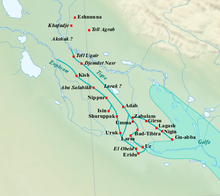
Back Vroegdinastiese Tydperk van Mesopotamië Afrikaans عصر فجر السلالات Arabic Període dinàstic arcaic Catalan Frühdynastische Zeit (Mesopotamien) German Frua Dinastia Periodo (Mezopotamio) Esperanto Período Dinástico Arcaico Spanish Sumeri ajalugu Estonian Période des dynasties archaïques French Periode Dinasti Awal (Mesopotamia) ID Periodo Protodinastico (Mesopotamia) Italian
 | |
| Geographical range | Mesopotamia |
|---|---|
| Period | Bronze Age |
| Dates | fl. c. 2900 – c. 2350 BC (middle) |
| Type site | Tell Khafajah, Tell Agrab, Tell Asmar |
| Major sites | Tell Abu Shahrain, Tell al-Madain, Tell as-Senkereh, Tell Abu Habbah, Tell Fara, Tell Uheimir, Tell al-Muqayyar, Tell Bismaya, Tell Hariri |
| Preceded by | Jemdet Nasr Period |
| Followed by | Akkadian Period, Early Assyrian Period |

The Early Dynastic period (abbreviated ED period or ED) is an archaeological culture in Mesopotamia (modern-day Iraq) that is generally dated to c. 2900 – c. 2350 BC and was preceded by the Uruk and Jemdet Nasr periods. It saw the development of writing and the formation of the first cities and states. The ED itself was characterized by the existence of multiple city-states: small states with a relatively simple structure that developed and solidified over time. This development ultimately led to the unification of much of Mesopotamia under the rule of Sargon, the first monarch of the Akkadian Empire. Despite this political fragmentation, the ED city-states shared a relatively homogeneous material culture. Sumerian cities such as Uruk, Ur, Lagash, Umma, and Nippur located in Lower Mesopotamia were very powerful and influential. To the north and west stretched states centered on cities such as Kish, Mari, Nagar, and Ebla.
The study of Central and Lower Mesopotamia has long been given priority over neighboring regions. Archaeological sites in Central and Lower Mesopotamia—notably Girsu but also Eshnunna, Khafajah, Ur, and many others—have been excavated since the 19th century. These excavations have yielded cuneiform texts and many other important artifacts. As a result, this area was better known than neighboring regions, but the excavation and publication of the archives of Ebla have changed this perspective by shedding more light on surrounding areas, such as Upper Mesopotamia, western Syria, and southwestern Iran. These new findings revealed that Lower Mesopotamia shared many socio-cultural developments with neighboring areas and that the entirety of the ancient Near East participated in an exchange network in which material goods and ideas were being circulated.
- ^ Art of the First Cities: The Third Millennium B.C. from the Mediterranean to the Indus. Metropolitan Museum of Art. 2003. p. 79. ISBN 978-1-58839-043-1.
© MMXXIII Rich X Search. We shall prevail. All rights reserved. Rich X Search